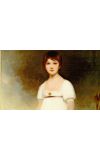
12 Jun 2012 09:37:35
New evidence may have revealed the true face of one of Britain's most beloved authors. Using digital photographic tools analysis has revealed writing on a long-disputed oil painting that its owners claim shows Jane Austen as a teenage girl. No other professional likeness of the writer exists.
The discovered words appear to include not only the novelist's name, but also that of the suspected artist.
In the top-right corner of a reproduction of a photograph of the portrait taken before the painting was restored, the name Jane Austen is visible. Next to it is revealed in two places the name Ozias Humphry – an established portrait painter of the period. He was a member of the Royal Academy, and a friend of other better-known artists of the day, such as Gainsborough and Romney.
The words have been digitally enhanced using photographic tools and methods that have been independently validated by photographic expert Stephen Cole of Acume Forensics in Leeds, who has spent more than 20 years analysing photographic evidence in criminal cases.
Art critic Angus Stewart, a former curator of an exhibition dedicated to Jane Austen, has seen the evidence and is impressed. "To have all these words revealed on the canvas is very, very strong. I think you'd be flying in the face of reason to deny this," he said.
The painting, owned by the Rice family, direct descendants of one of Jane's brothers, has been the subject of debate almost since it came to public light in the late 19th century. The Rices say it was composed during an Austen family visit to the house of Jane's great uncle Francis, in Kent in 1789, when Jane was 13. According to the recorded family history, having commissioned the portrait Francis kept it in Sevenoaks with the rest of his family collection. It was then given by his grandson, Colonel Thomas Austen, to a close friend as a wedding present, the year after the author died in 1817, because the bride was reported to be a keen admirer of Austen's books.
However, since the 1940s art experts, led by the National Portrait Gallery, have raised objections, principally that the style of the girl's dress and the general composition date the painting after 1800. By then, Jane Austen would have been in her 20s, too old to be the girl depicted. But the new evidence also provides important clues that could contradict the established view. The digital analysis has been conducted on a photograph of the canvas dating back to 1910 when the photographer Emery Walker was hired to reproduce the image for a collection of Jane Austen's letters. The original glass plates have since been stored in the National Portrait Gallery's own reference library, and have only now been digitally reproduced.
Since 1910 the painting has undergone successive restorations which may have erased crucial clues on the surface, so this black-and-white photograph may contain evidence lost on the original.
Francis Austen was a patron of Humphry's work, and had himself sat for a portrait by the artist. Crucially, Humphry also became blind in 1797 and stopped painting – so this attribution would date the picture before then. Intriguingly the enhancements also seem to reveal the date 1789, at which time Jane Austen was 13, the right age to be the girl in the painting.
It's not possible to know whether any of this writing was placed on the canvas by Humphry himself or a later owner. But as the painting was believed to be by a better known and more prestigious artist, Johann Zoffany, it seems to experts overwhelmingly likely that the words must have been put there during or shortly after Jane's lifetime. Professor Claudia Johnson of Princeton University believes the new evidence trumps the historical objections: "Whether Humphry's name was signed by himself in the 18th century and/or by some other hand later, the attribution must be contemporaneous with Austen's lifetime or by people who knew Austen when she was alive," she said.
A definitive attribution of the portrait as Austen may represent something of an embarrassment to the National Portrait Gallery, which granted the picture a licence for sale abroad on the basis that it could not be the writer. The gallery chose not to comment.
Thanks to the scholarly doubt, the picture failed to reach a £350,000 reserve price at auction in 2007. But now the Rice family can perhaps expect a much higher sale price.

